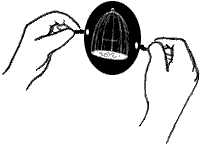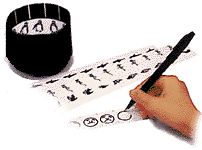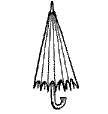 |
PRE-CINEMA ANIMATION DEVICES |
 |
 |
ZOETROPES, THAUMATROPES, PRAXINOSCOPES |
| The zoetrope is one of several animation toys which were invented in the 19th century, as people experimented with ways to make moving pictures. The zoetrope appeared first in England in 1834, then France in 1860 and finally the United States in 1867. The "Daedatelum" was invented by William George Horner in 1834 and renamed "Zoetrope" by French inventor, Pierre Desvignes. In "zoetrope" you might recognize the root word "zoo" from a Greek word meaning animal or life. "Trope" is also from Greek and refers to things that turn. |
Make your own zoetrope.
|
 |
Unfortunately no longer in production, here's a small zoetrope originally produced by DaMert who hired me to make a set of 12 animated strips for it. Rufus Butler Seder, the creative force at Eye Think, Inc. then revamped and improved it adding a lot of new strips. |
 |
 |
The zoetrope is the wheel of life. When you place a strip of drawings inside the zoetrope's drum, spin it and look through the slots, you will see the images come to life. Of course, they are not really alive. Our perceptual apparatus (brains + eyes) makes the connection between one image and the next. There are several theories that have been developed to explain this: "persistence of vision," "flicker fusion," the "phi phenomenon" and "beta movement." |
|
Persistence of vision, refers to the length of time the retina (the "screen" at the back of our eyes which receives light) retains an image. Flicker fusion is related; if we see a light flash every tenth of a second or less, we perceive it as continuous. The impression of each flash of light remains, or persists, in the retina for at least one-tenth of a second.
Because of this persistence, we can't tell where one flash ends and the next begins. Instead, we perceive a continuous light. If, when you spin the zoetrope, you look over the top of the drum at the drawings instead of looking through the slots all you will see is a blur. The illusion of motion is gone. But the zoetrope drum is black, so its slots simulate flashes of light, creating a strobe. The illusion of motion is a stroboscopic effect. The images you see must be interrupted by moments of darkness in order for the illusion to work. |
| The phi phenomenon and beta movement have to do with perception of motion and howler brains are hard-wired to try to make meaning from what we see. When we see different images close together our brains quickly create a relationship between them. The metamorphosis of an umbrella into a mushroom makes a certain kind of sense, even though this is not something you would ever see in the real world. |  |
|
Movies are composed of shots of different characters and events taken from a variety of angles and distances edited together.
A skilled editor takes advantage of our brains' capacity to make meaning, maximizing the illusion of continuity so we may not consciously notice the cuts. But we, as viewers, are most responsible for continuity. We see the shots together, and our mind creates a world from them which seems to have its own space and time. The zoetrope and other nineteenth century animation devices such as the flipbook, thaumatrope, praxinoscope and mutoscope were steps in the development of film and television. On the surface, modern media technologies look different from the optical toys of the 1800s, but they share common properties. The zoetrope has slots that create a stroboscopic effect. Film projectors have a shutter that interrupts the light from the projector bulb as the film advances through the gate. The strobe of the projector shutter keeps the film from blurring. Video images are scanned onto the monitor screen by a beam which zig-zags across the screen from top to bottom twice for each frame. In between each frame is a little black, which you may see in an older television set as a roll-bar when its vertical hold needs adjustment. The zoetrope's speed is variable. The faster it turns, the smoother the motion appears. When the zoetrope slows down so that each image is seen for a tenth of a second or more, the illusion of movement begins to break down and the strobe is more obvious. Film projectors usually run at a rate of 24 frames, or pictures, per second. VCR and DVD players play and/or record at a rate of 30 frames per second. But old silent movie projectors run at 16 or 18 frames per second. They are so slow they seem to flicker. |
Homepage | Flipbooks | Films and Videos | Links & Resources
![]()
Copyright Ruth Hayes 2023